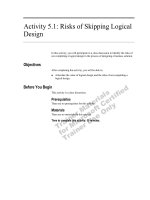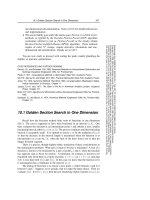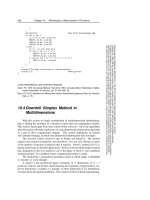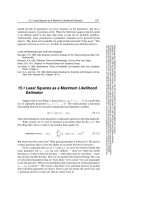II ADVANCED APPLICATION OF INDUSTRIAL SERVO DRIVES doc
Bạn đang xem bản rút gọn của tài liệu. Xem và tải ngay bản đầy đủ của tài liệu tại đây (941.69 KB, 30 trang )
II
ADVANCED APPLICATION OF
INDUSTRIAL SERVO DRIVES
Copyright 2003 by Marcel Dekker, Inc. All Rights Reserved
7
Background
7.1 INTRODUCTION
Part I discussed the basics of industrial servo drives from a hardware point
of view. Physical parameters and practical applications were discussed. Part
II repeats some of the things in Part I but from a mathematical point of
view. The advanced application of industrial servo drives requires the use of
differential equations to describe mechanical, electrical, and fluid systems.
As applied to servo drives there are numerous academic techniques to
analyze these systems (e.g., root locus, Nyquist diagrams, etc.). In working
with industrial machinery we live in a sinusoidal world with such things as
structural machine resonances. Thus frequency analysis is used in Part II to
describe and analyze industrial servo systems. To solve the differential
equations describing the physical systems of servo drives, transformation
calculus is used to obtain the required transfer functions for the components
of servo drives and in analyzing the servo system.
There are a multitude of academic textbooks and university courses
dealing with feedback control. It is the purpose of Part II to show how the
fundamentals of servo drives described in the many academic sources are
applied in practice.
Copyright 2003 by Marcel Dekker, Inc. All Rights Reserved
7.2 PHYSICAL SYSTEM ANALOGS, QUANTITIES,
AND VECTORS
As a beginning, analogous parameters for an electrical system, a linear
mechanical system, and a rotary mechanical system are compared for future
reference. In all physical systems there are scalar quantities and vector
quantities. Vector quantities can be represented as complex numbers on a
complex plane, in polar form, or in exponential form as in Eq. (7.2-1) to
(7.2-12).
Scalar Quantities
(a) Magnitude only
(b) Examples: length of a line, mass, volume
Vector Quantities
(a) Magnitude and direction
(b) Examples: force, voltage, weight, velocity
Complex Numbers
A vector can be represented by its rectilinear components.
sin y ¼
F
y
F
cos y ¼
F
x
F
(7.2-1)
F
y
¼ F sin y F
x
¼ F cos y (7.2-2)
jFj¼
ffiffiffiffiffiffiffiffiffiffiffiffiffiffiffiffiffiffiffiffiffiffiffiffiffiffiffi
ðF
x
Þ
2
þðF
y
Þ
2
q
(7.2-3)
y ¼ tan
À1
F
y
F
x
(7.2-4)
;
FF ¼
ffiffiffiffiffiffiffiffiffiffiffiffiffiffiffiffiffiffiffiffiffiffiffiffiffiffiffiffiffiffiffiffiffiffiffiffiffiffiffiffiffiffiffiffiffi
ðF cos yÞ
2
þðF sin yÞ
2
q
ffy ¼ tan
À1
F
y
F
x
(7.2-5)
A vector can also be represented on a complex plane.
Copyright 2003 by Marcel Dekker, Inc. All Rights Reserved
FF ¼ F
x
þ jF
y
(7.2-6)
FF ¼ðjFjcos yÞþjðjFjsin yÞ (7.2-7)
j ¼
ffiffiffiffiffiffiffi
À1
p
(7.2-8)
A vector can be represented in polar form.
FF ¼jFjffy (7.2-9)
FF ¼
ffiffiffiffiffiffiffiffiffiffiffiffiffiffiffiffiffiffiffiffiffiffiffiffiffiffiffi
ðF
x
Þ
2
þðF
y
Þ
2
q
ffy ¼ tan
À1
F
y
F
x
(7.2-10)
A vector can be represented in exponential form.
FF ¼jFje
jy
y ¼ tan
À1
F
y
F
x
(7.2-11)
Thus:
Rectangular Polar Exponential
F cos y þjF sin y ¼jFjffy ¼jFje+
jy
(7.2-12)
7.3 DIFFERENTIAL EQUATIONS FOR PHYSICAL
SYSTEMS
The differential equations for physical systems can be written for individual
servo components such as motors and amplifiers or for complete multiloop
servo drives. In actual practice servo drive block diagrams can be put
together with a combination of individual transfer functions representing
the differential equation of the separate servo drive components. These
individual transfer characteristics can, in general, be represented by single-
order or second-order blocks in the overall servo block diagram. A single-
order differential equation or transfer characteristic results from a circuit
having a single time-varying parameter. Likewise, a second-order transfer
characteristic results from a circuit (mechanical, electrical, or fluid) having
two time-varying parameters. Most servo drive components can be
represented by either a first-order transfer characteristic (or transfer
function) or a second-order transfer function. A transfer function is, by
definition, the ratio of the Laplace transform of the output to the Laplace
transform of the input. In general a transfer function is a shorthand solution
for solving differential equations.
The derivation of a single-order electrical circuit transfer function
having an inductor as a single time-varying parameter is shown in Figure 1.
The steady-state equations for the output voltage, based on a sinusoidal
Copyright 2003 by Marcel Dekker, Inc. All Rights Reserved
input voltage, are 7.3-1 to 7.3-17. Replacing the jo term by the differential
operator p or the Laplace transform operator s changes Eq. (7.3 -10) to the
transform function of Eq. (7.3-19). This transform function can be
represented in the frequency response of Figure 2.
To illustrate a second-order circuit, the circuit of Figure 3 with two
time-varying parameters has the differential equation of Eq. (7.3-20). The
output voltage for the unique case of a sinusoidal input voltage is Eq. (7.3-
25). A second-order mechanical circuit for linear translation is shown in
Figure 4. Eq. (7.3-30) is the differential equation for this circuit. Assuming a
sinusoidal input, the output displacement is Eq. (7.3-35). Lastly, a rotary
mechanical circuit is shown in Figure 5. The output angular motion is Eq.
(7.3-44). These examples of single-order and second-order circuits are to
illustrate that individual servo drive components can be represented
mathematically by differential equations, transfer functions, or the absolute
case for a sinusoidal input driving source.
The circuit shown in Figure 1 is further described for three cases of
absolute, vector, or differential analysis followed by the response of this
circuit to a step input and a ramp input.
e
i
¼ iR
e
þ iX
L
(7.3-1)
e
i
¼ iZ (7.3-2)
X
L
¼ 2pf ffo
L
(7.3-3)
Zffy ¼ Zðcos y þj sin yÞ (7.3-4)
Fig. 1 (a) Inductive/resistive circuit. (b) Circle diagram.
Copyright 2003 by Marcel Dekker, Inc. All Rights Reserved
Fig. 2 Single-order frequency response.
Copyright 2003 by Marcel Dekker, Inc. All Rights Reserved
Note: a þjb ¼ cffy :
Z
R
e
Z
þ j
X
L
Z
¼ R
e
þ jX
L
(7.3-5)
e
i
¼ iðR
e
þ jX
L
Þ¼iðR
e
þ jo
L
Þ (7.3-6)
i ¼
e
i
R
e
þ jo
L
¼
e
i
R
e
1 þjo
L
L
R
e
(7.3-7)
Fig. 3 Inductive/capacitive/resistive circuit.
Fig. 4 Spring/mass diagram (linear).
Fig. 5 Spring/mass diagram (rotary).
Copyright 2003 by Marcel Dekker, Inc. All Rights Reserved
L
R
¼ T
1
(7.3-8) (7.3-8)
i ¼
e
i
R
e
ð1 þjoT
1
Þ
¼
e
i
Z
(7.3-9)
e
o
¼ R
e
i ¼
e
i
ð1 þjoT
1
Þ
(7.3-10)
For
1 þjoT
1
¼ Z (7.3-11)
e
o
e
i
¼
1
ffiffiffiffiffiffiffiffiffiffiffiffiffiffiffiffiffiffiffiffiffiffiffi
1 þðoT
1
Þ
2
q
ffy ¼ tan
À1
oT
1
1
(7.3-12)
e
o
e
i
¼
1
ffiffiffiffiffiffiffiffiffiffiffiffiffiffiffiffiffiffiffiffiffiffiffi
1 þðoT
1
Þ
2
q
ffÀy ¼ tan
À1
oT
1
1
(7.3-13)
T
1
¼
1
o
1
(7.3-14)
e
o
e
i
¼
1
ffiffiffiffiffiffiffiffiffiffiffiffiffiffiffiffiffiffiffiffiffiffi
1 þ
o
o
1
2
r
ffÀy ¼ tan
À1
o
o
1
(7.3-15)
For
o ¼ o
1
; ;y ¼À45
:
Amplitude ratio ¼
1
ffiffiffi
2
p
¼ 0:707 (7.3-16)
;
e
o
e
i
¼ 0:707ffÀ45
(7.3-17)
An example of a complex plane plot is:
Copyright 2003 by Marcel Dekker, Inc. All Rights Reserved
e
o
¼ K
i
¼
R
e
e
i
R
e
þ pL
i
¼
e
i
1 þ
L
i
R
e
p
¼
e
i
1 þ
L
i
R
e
s
(7.3-18)
e
o
e
i
¼
1
ð1 þtsÞ
(7.3-19)
e
i
¼ R
e
i þ
di
dt
L
i
þ
Z
idt
C
a
(7.3-20)
d
dt
¼ p
Z
ðf Þtdt¼
1
p
(7.3-21)
For sinusoidal input,
p ¼ jo (7.3-22)
e
i
¼ iR
e
þ joL
i
þ
1
joC
a
(7.3-23)
i ¼
e
i
R þjoL
i
þ
1
joC
a
¼
e
i
joC
a
½jRoC
a
þðjoÞ
2
LC
a
þ 1
(7.3-24)
e
o
¼
e
i
joRC
a
½ðjoÞ
2
L
i
C
a
þ joRC
a
þ 1
(7.3-25)
Quadratic :
ðjoÞ
2
o
2
þ
2d
o
jo þ 1 (7.3-26)
o ¼
ffiffiffiffiffiffiffiffiffiffi
1
L
i
C
a
s
(7.3-27)
SF ¼ M
a
¼ F Àkx À c
dx
dt
(7.3-28)
M
a
d
2
x
dt
2
¼ F Àkx Àc
dx
dt
(7.3-29)
M
a
d
2
x
dt
2
þ c
dx
dt
þ kx ¼ F (7.3-30)
For f ¼F sin ot, the diff erential
d
dt
¼ jo ¼ p (7.3-31)
Copyright 2003 by Marcel Dekker, Inc. All Rights Reserved
where p is the differential operator.
M
a
p
2
x þ cpx þkx ¼ F (7.3-32)
ðM
a
p
2
þ cp þ kÞx ¼ F (7.3-33)
½M
a
ðjoÞ
2
þ cjo þ kx ¼ F (7.3-34)
x ¼
F
ðjoÞ
2
M
a
þ joc þ k
¼
F=k
ðjoÞ
2
k=M
a
þ jo
c
k
þ 1
(7.3-35)
For quadratic:
ðjoÞ
2
o
2
þ
2d
o
jo þ 1
"#
(7.3-36)
o
n
¼
ffiffiffiffiffiffiffi
k
M
a
s
2d
o
¼ c=k (7.3-37)
d ¼
c
k
o
2
(7.3-38)
ST ¼ Ja
ST ¼ J
d
2
y
0
dt
2
¼ G
T
ðy
1
À y
0
ÞÀb
dy
0
dt
(7.3-39)
d
dt
¼ p Differential operator (7.3-40)
Jp
2
y þ bpy
0
þ G
T
y
0
¼ G
T
y
1
(7.3-41)
½Jp
2
þ bp þ G
T
y
0
¼ G
T
y
1
(7.3-42)
For:
y
1
¼ y
1
sin otp¼ jo
½JðjoÞ
2
þ bjo þ G
T
y
0
¼ G
T
y
1
(7.3-43)
y
0
¼
G
T
y
1
ðjoÞ
2
J þjob þG
T
¼
y
1
ðjoÞ
2
ðG
T
=JÞ
þ
b
G
T
jo þ1
(7.3-44)
Copyright 2003 by Marcel Dekker, Inc. All Rights Reserved
For quadratic:
ðjoÞ
2
o
2
þ
2d
o
þ 1
"#
(7.3-45)
o ¼
ffiffiffiffiffiffiffi
G
T
J
r
2d
o
¼
b
G
T
(7.3-46)
d ¼
b
G
T
o
2
(7.3-47)
Absolute Vector Differential
je
i
j¼R
i
þ x
L
i
ee
i
¼ R
i
þ jx
L
ie
iðtÞ
¼ R
i
þff
di
dt
p ¼
d
dt
je
i
j¼jijðR
i
þ x
L
Þ
ee
i
¼
iiðR þ jx
L
Þ e
iðtÞ
¼ i
ðtÞ
ðR þ LpÞ
je
i
j¼jijðR þ 2pf
L
Þ
ee
i
¼
iiðR þ 2pf
L
Þ
jij¼
je
i
j
ðRþoLÞ
ii ¼
ee
i
RþjoL
i
ðtÞ
¼
e
iðtÞ
ðRþLpÞ
jij¼
je
i
j
jZj
ii ¼
ee
i
Z
jij¼
je
i
j
ffiffiffiffiffiffiffiffiffiffiffiffiffiffiffiffi
R
2
þðoLÞ
2
p
i ¼
e
i
ffÀtan
À1 XL
R
ffiffiffiffiffiffiffiffiffiffiffiffiffiffiffiffi
R
2
þðoLÞ
2
p
je
o
j¼jijR ¼
Rje
i
j
ffiffiffiffiffiffiffiffiffiffiffiffiffiffiffiffi
R
2
þðoLÞ
2
p
ee
o
¼
iiR ¼
R
ee
i
RþjoL
e
oðtÞ
¼ i
ðtÞ
R ¼
Re
iðtÞ
ðRþLpÞ
je
o
j¼
je
i
j
ffiffiffiffiffiffiffiffiffiffiffiffiffiffiffiffiffiffi
ð1Þ
2
þ o
L
R
ðÞ
2
q
ee
o
¼
ee
i
1þj o
L
R
ðÞ
e
oðtÞ
¼
e
iðtÞ
1þ
L
R
p
ðÞ
L
R
¼ T
1
je
o
j¼
je
i
j
ffiffiffiffiffiffiffiffiffiffiffiffiffiffiffiffiffiffiffi
ðT
1
oÞ
2
þð1Þ
2
p
ee
o
¼
ee
i
ðT
1
joþ1Þ
e
oðtÞ
¼
e
iðtÞ
ðT
1
pþ1Þ
ee
o
¼
ee
i
ðj
o
o
1
þ1Þ
e
oðsÞ
¼
e
iðsÞ
ðT
1
sþ1Þ
Copyright 2003 by Marcel Dekker, Inc. All Rights Reserved
Examples
Absolute Case
e
i
¼ 10 V at 60 Hz
R ¼ 5 O
L ¼ 0:2H
je
o
j¼
e
i
ffiffiffiffiffiffiffiffiffiffiffiffiffiffiffiffiffiffiffiffiffiffiffiffiffiffiffi
R
2
þð2pfLÞ
2
q
¼
1065
ffiffiffiffiffiffiffiffiffiffiffiffiffiffiffiffiffiffiffiffiffiffiffi
5
2
þð377Þ
2
q
¼
50
ffiffiffiffiffiffiffiffiffiffiffiffiffiffiffiffiffiffiffiffiffi
25 þ5679
p
¼
50
7513
¼ 0:66 V
je
o
j¼
e
i
ffiffiffiffiffiffiffiffiffiffiffiffiffiffiffiffiffiffiffiffiffiffiffi
ðT
1
oÞ
2
þ 1
q
¼
10
ffiffiffiffiffiffiffiffiffiffiffiffiffiffiffiffiffiffiffiffiffiffiffiffiffiffiffi
0:262pf
R
2
þ1
r
¼
10
ffiffiffiffiffiffiffiffiffiffiffiffiffiffiffiffi
227 þ1
p
¼
10
15:1
¼ 0:66 V
Vector Case
e
i
¼ 10ffy
V
R ¼ 5 O
L ¼ 0:2H
f ¼ 60 Hz
ee
o
¼
ee
i
6R
ffiffiffiffiffiffiffiffiffiffiffiffiffiffiffiffiffiffiffiffiffiffiffiffi
R
2
þðoLÞ
2
q
fftan
À1
oL
R
¼
10ff0
65
75:3ff86
¼ 0:66ffÀ86
ee
o
¼
ee
i
T
1
jo þ 1
¼
10ff0
L
R
2pfj þ 1
¼
10ff0
15j þ 1
¼
10ff0
15:1ff86
¼ 0:66ffÀ86
Differential Case
R ¼ 5 O
L ¼ 0:2H
e
oðsÞ
¼
e
iðsÞ
ðT
1
s þ1Þ
¼
e
iðsÞ
0:2
5
s þ1
ÀÁ
¼
e
iðsÞ
ð0:04 s þ1Þ
Copyright 2003 by Marcel Dekker, Inc. All Rights Reserved
For the Case of Sinusoidal Input
e
iðtÞ
¼ E sin otE¼ 10 V
e
iðsÞ
¼
Eo
ðs
2
þ o
2
Þ
e
oðsÞ
¼
Eo
ðs
2
þ o
2
Þð0:04 s þ1Þ
¼
25610o
ðs
2
þ o
2
Þðs þ 25Þ
e
oðtÞ
¼ 250o
"
e
À25t
ð25Þ
2
þ o
2
þ
sinðot ÀyÞ
o
ffiffiffiffiffiffiffiffiffiffiffiffiffiffiffiffiffiffiffiffiffiffi
ð25Þ
2
þ o
2
q
#
o ¼ 377
e
oðtÞ
¼ 2506377
e
À25t
142;750
þ
sinðot ÀyÞ
142;440
!
Phase ¼ y ¼ tan
À1
o
25
y ¼ 86
E
À25t
142;750
<<< 1
e
oðtÞ
¼
94;250
142;440
sinðot À86
Þ
e
oðtÞ
¼ 0:66 sinðot À86
Þ
e
o
¼ 0:66 V at phase of À 86
For Case Where e
i(t)
¼Step ¼E (Figure 6a)
e
iðtÞ
¼ E
e
iðsÞ
¼
E
s
T
1
¼ 0:04 sec
e
iðsÞ
¼
E
sðT
1
s þ1Þ
¼
25E
sðs þ 25Þ
e
oðtÞ
¼ Eð1 À e
À25t
Þ
Copyright 2003 by Marcel Dekker, Inc. All Rights Reserved
For Case Where e
i(t)
¼Ramp ¼E
t
(Figure 6b)
e
iðtÞ
¼ Et
e
iðsÞ
¼
E
s
2
e
oðsÞ
¼
25E
s
2
ðs þ25Þ
¼
Eðe
À25t
þ 25t À 1Þ
25
7.4 ELECTRIC SERVO MOTOR TRANSFER
FUNCTIONS AND TIME CONSTANTS
In Section 7.3 some simple first- and second-order mathematical descrip-
tions were given to illustrate how the corresponding transfer functions were
developed. In Part I, the components of servo drives were described from a
physical point of view. These servo-drive components are now described
from a mathematical or transfer function point of view.
In the analysis of electric servo-drive motors, the equations for the
motor indicates the presence of two time constants. One is a mechanical
time constant and the other is an electrical time constant. Commercial
servo-motor specifications usually list these two time constants. However, it
should be cautioned that these two time constants as given in the
specifications are for the motor alone with no load inertia connected to
Fig. 6b For case where e
iðtÞ
¼ RAMP ¼ E
t
.
Fig. 6a Step response.
Copyright 2003 by Marcel Dekker, Inc. All Rights Reserved
the motor shaft. Since these two time constants are part of the motor block
diagram used in servo analysis, it is important to know the real value of the
time constants under actual load conditions.
There are two types of servo motors to consider. The first is the
classical DC servo motor and the second is the AC servo motor often
referred to as a brushless DC motor. The brushless DC motor is a three-
phase synchronous motor having a position transducer inside the motor to
transmit motor shaft position to the drive amplifier for the purpose of
controlling current commutation in the three phases of the motor windings.
A derivation of the motor equations and the electrical and mechanical
motor time constants will be discussed for the DC motor followed by a
discussion for the AC motor. The DC motor equivalent diagram is shown in
Figure 8, where:
e
I
¼Applied voltage (volts)
i
a
¼Armature current (amps)
J
T
¼Total inertia of motor armature plus load (lb-in sec
2
)
K
e
¼Motor voltage constant (V/rad/sec)
K
T
¼Motor torque constant (lb-in./A)
Fig. 7 Ramp response.
Fig. 8 Equivalent diagram for a DC motor.
Copyright 2003 by Marcel Dekker, Inc. All Rights Reserved
L
a
¼Motor winding inductance (Henries)
R
a
¼Armature resistance (ohms)
T
L
¼Load torque (lb-in.)
V
m
¼Motor velocity (rad/sec)
a ¼Acceleration (rad/sec
2
)
The steady-state (DC) equations are:
e
i
¼ i
a
R
a
þ K
e
V
m
ðVoltage equationÞ (7.4-1)
T ¼ Torque ¼ i
a
K
T
¼ Ja ðTorque equationÞ (7.4-2)
For the general case, the differential equations are:
e
i
¼ i
a
R
a
þ L
a
di
a
dt
þ K
e
V
m
(7.4-3)
Laplace operator S ¼
d
dt
e
i
¼ R
a
i
a
þ L
a
Si
a
þ K
e
V
m
(7.4-4)
e
i
¼ðR
a
þ L
a
SÞi
a
þ K
e
V
m
(7.4-5)
e
i
¼
L
a
R
a
S þ 1
R
a
i
a
þ K
e
V
m
(7.4-6)
Also : T ¼ K
T
I
a
¼ J
T
a ¼ J
T
V
m
S (7.4-7)
i
a
¼
T
K
T
¼
J
T
V
m
S
K
T
(7.4-8)
Combining equations gives:
e
i
À K
e
V
m
¼
L
a
R
a
S þ 1
R
a
J
T
V
m
S
K
T
(7.4-9)
Rearranging results in:
ðe
i
À K
e
V
m
ÞK
T
ð
L
a
R
a
S þ 1ÞR
a
J
T
S
¼ V
m
(7.4-10)
This last equation can be represented in block diagram form as in
Figure 9.
The closed-loop equation ð
C
R
¼
G
1þGH
Þ for this block diagram is:
V
m
e
i
¼
K
T
R
a
J
T
S
L
a
R
a
S þ 1
hi
þ K
e
K
T
(7.4-11)
Copyright 2003 by Marcel Dekker, Inc. All Rights Reserved
Rearranging Eq. (7.4-11) gives:
V
m
e
i
¼
K
T
ðR
a
J
T
L
a
R
a
ÞS
2
þ J
T
R
a
S þ K
e
K
T
(7.4-12)
Dividing by Eq. (7.4-12), K
e
K
T
gives:
V
m
e
i
¼
1
K
e
R
a
J
T
K
e
K
T
L
a
R
a
S
2
þ
R
a
J
T
K
e
K
T
S þ 1
(7.4-13)
From the last equation, the motor mechanical time constant, t
m
,is:
t
m
¼
R
a
J
T
K
e
K
T
½sec (7.4-14)
The total inertia, J
T
, is the sum of the reflected inertia to the motor shaft
plus the motor inertia. The resistance, R
a
, is the motor winding resistance
plus the external circuit resistance. Thus the motor mechanical time constant
is summarized as:
t
m
¼
P
R
a
J
T
K
e
K
T
½sec (7.4-15)
Also, the motor electrical time constant is:
t
e
¼
L
a
P
R
a
½sec (7.4-16)
Fig. 9 DC motor block diagram.
Copyright 2003 by Marcel Dekker, Inc. All Rights Reserved
Therefore, the closed-loop motor equation can be expressed as:
V
m
e
i
¼
1
K
e
t
m
t
e
S
2
þ t
m
S þ1
(7.4-17)
From the general equation for a quadratic:
S
2
o
2
m
þ
2dS
o
m
þ 1 (7.4-18)
where:
o
m
¼
ffiffiffiffiffiffiffiffiffiffiffiffiffi
1=t
m
t
e
p
(7.4-19)
The damping factor is:
d ¼ 0:5t
m
o
m
¼ 0:5t
m
ffiffiffiffiffiffiffiffiffiffiffiffiffi
1=t
m
t
e
p
¼ 0:5
ffiffiffiffiffiffiffiffiffiffiffi
t
m
=t
e
p
(7.4-20)
The mechanical and electrical time constants for a brushless DC motor have
the same basic equations with some variations. For a brushless DC motor
with a wye connected motor, the electrical circuit is as shown in Figure 10.
The mechanical time constant is:
t
m
¼
P
R
PHASE
J
TOTAL
K
eðPHASEÞ
K
T
½sec (7.4-21)
where:
K
eðPHASEÞ
¼ Motor voltage constant ¼
K
eðLÀLÞ
1:73
VÀsec
RAD
ÂÃ
K
T
¼ Motor torque constant
lbÀin:
A
rms
hi
R
MðLÀLÞ
¼ Motor resistance [ohms]
P
R
MðLÀLÞ
¼ Total motor circuit resistance ¼ 1:35R
MðLÀLÞ
½ohms
Fig. 10 Equivalent diagram for a WYE connected brushless DC motor.
Copyright 2003 by Marcel Dekker, Inc. All Rights Reserved
P
R
MðPHASEÞ
¼
P
R
MðLÀLÞ
60:5 ¼½ohms
L
LÀL
¼ Motor inductance ¼½Henries
J
TOTAL
¼ Motor armature inertia plus the reflected load inertia
at the motor shaft ¼½lb:-in:-sec
2
Most manufacturers give the electrical parameters in line-to-line values.
Thus some of these values must be converted to the phase values as shown in
the preceding text. Summarizing, the mechanical time constant can be
computed as:
t
m
¼
P
R
LÀL
2
J
TOTAL
K
eðLÀLÞ
1:73
K
T
½sec¼0:86
R
lÀl
J
totalatmotor
K
eðlÀlÞ
K
T
(7.4-22)
The electrical time constant for the brushless DC motor is computed as:
t
e
¼
Total inductive path
Total resistive path
¼
L
LÀL
P
R
mðLÀLÞ
½sec (7.4-23)
Another factor affecting the mechanical time constant is the temperature.
Most manufacturers specify the motor parameters at 258C (cold rating).
This implies that the magnet and wires are both at room temperature.
However, the motors used in industry will operate hotter, which means
could reach a magnet temperature of 808Cto908Cina408C ambient. The
winding temperature is considerably more than that. Some means must be
used to compensate for the motor parameters rated at 258C. For those
manufacturers that offer the hot rating on motor specification parameters,
they should be used to calculate the time constants. The parameters of
motor resistance, torque constant, and voltage constant should be adjusted,
if needed, for the hot rating. The motor resistance will increase; the torque
constant and voltage constant will decrease. However, contrary to their
implied name both time constants are not of constant value. Rather, they
are both functions of the motor’s operating temperature.
The electrical resistance of a winding, at a specified temperature, is
determined by the length, gauge and composition (i.e., copper, aluminum,
etc.) of the wire used to construct the winding. The winding in the vast
majority of industrial servo motors are constructed using film-coated copper
magnet wire. Based on the 1913 International Electrical Commission
standard, the linear temperature coefficient of electrical resistance for
annealed copper magnet wire is 0.00393/8C. Hence, knowing a copper
winding’s resistance at a specified reference or ambient temperature, the
windings at temperatures above or below this ambient temperature is given
Copyright 2003 by Marcel Dekker, Inc. All Rights Reserved
by:
RðTÞ¼RðT
0
Þ½1 þ0:00393ðT ÀT
0
Þ (7.4-24)
where:
T ¼ Winding’s Temperature ð
CÞ
T
0
¼ Specified Ambient Temperature ð
CÞ:
Using Eq. (7.4-24), a 1308C rise (1558C–258C) in a copper winding’s
temperature increases its electrical resistance by a factor of 1.5109.
Correspondingly, the motor’s mechanical time constant increases by this
same 1.5109 factor while its electrical time constant decreases by a factor of
1/1.5109 ¼0.662. In combination, the motor’s mechanical to electrical time
constant ratio increases by a factor of 2.28 and this increase definitely affects
how the servo motor dynamically responds to a voltage command.
In consulting published motor data, many motor manufacturers
specify their motor’s parameter values, including resistance, using 258Cas
the specified ambient temperature. NEMA, however, recommends 408Cas
the ambient temperature in specifying motors for industrial applications.
Therefore, pay close attention to the specified ambient temperature when
consulting or comparing published motor data. Different manufacturers
can, and sometimes do, use different ambient temperatures in specifying
what can be the identical motor.
In the same published data servo motors are generally rated to operate
with either a 1308C (Class B) or 1558C (Class F) continuous winding
temperature. Although motors with a Class H, 1808C temperature rating are
also available. Assuming the motor’s resistance along with its electrical and
mechanical time constants are specified at 258C, it was just demonst rated
that all three parameters significantly change value at a 1558Cwinding
temperature. If the motor’s winding can safely operate at 1808C the
resistance change is even greater because Eq. (7.4-24) shows that a 1558C
rise (1808C–258C) in winding temperature increases its electrical resistance
by a factor of 1.609. Hence, if the servo motor’s dynamic motion response is
calculated using the 258C parameter values then this calculation over-
estimates the motor’s dynamic response for all temperatures above 258C.
In all permanent magnet motors there is an additional effect that
temperature has on the motor’s mechanical time constant only. As shown in
Eq. (7.4-24), a motor’s mechanical time constant changes inversely with any
change in both the back EMF, K
e
, and torque constant, K
T
. Both K
e
and
K
T
have the same functional dependence on the motor’s air gap magnetic
flux density produced by the motor’s magnets. All permanent magnet
Copyright 2003 by Marcel Dekker, Inc. All Rights Reserved
motors are subject to both reversible and irreversible demagnetization.
Irreversible demagnetization can occur at any temperature and must be
avoided by limiting the motor’s current such that, even for an instant, it
does not exceed the peak current/torque specified by the motor manufac-
turer. Exceeding the motor’s peak current rating can permanently reduce the
motor’s K
e
and K
T
thereby increasing the motor’s mechanical time constant
at every temperature including the specified ambient temperature.
Reversible thermal demagnetization depends on the specific magnet
material being used. Currently, there are four different magnet materials
used in permanent magnet motors. The four materials are Aluminum-
Nickel-Cobalt (Alnico), Samarium Cobalt (SmCo), Neodymium-Iron-
Boron (NdFeB), and Ferrite or Ceramic magnets as they are often called.
In the temperature range, À60
C < T < 200
C, all four magnet materials
exhibit reversible thermal demagnetization such that the amount of air gap
magnetic flux density they produce decreases linearly with increasing magnet
temperature. Hence, similar to electrical resistance, the expression for the
reversible decrease in both K
e
(T) and K
T
(T) with increasing magnet
temperature is given by:
K
e;T
ðTÞ¼K
e;T
ðT
0
Þ½1 ÀBðT ÀT
0
Þ (7.4-25)
In Eq. (7.4–25), the B-coefficient for each magnet material amounts to:
B(Alnico) ¼0.0001/8C
B(SmCo) ¼0.00035/8C
B(NdFeB) ¼0.001/8C
B(Ferrite) ¼0.002/8C
Using Eq. (7.4-25) it can be calculated that a 1008C rise in magnet
temperature causes a reversible reduction in both K
e
and K
T
that amounts
to 1% for Alnico, 3.5% for SmCo, 10% for NdFeB, an d 30% for Ferrite or
Ceramic magnets. Like the motor’s electrical resistance, most motor
manufacturers specify the motor’s K
e
and K
T
using the same ambient
temperature used to specify resistance. However, this is not always true and
it is again advised to pay close attention as to how the manufacturer is
specifying their motor’s parameter values.
Combining the effects of reversible, thermal demagnetization with
temperature dependent resistance, the equation describing how a permanent
magnetic motor’s mechanical time constant increases in value with
increasing motor temperature amounts to:
t
m
ðTÞ¼t
m
ðT
0
Þ
½1 þ0:00393ðT À T
0
Þ
½ð1 ÀBðT À T
0
ÞÞ
2
(7.4-26)
Copyright 2003 by Marcel Dekker, Inc. All Rights Reserved
Notice in Eq. (7.4-26) that the magnet’s temperature is assumed equal to the
motor’s winding temperature. Actual measurement shows that this
assumption is not always correct. Motor magnets typically operate at a
lower temperature compared to the winding’s temperature. However this
conservative approximation is recommended and used.
An example will be given to illustrate a change in time constants. To
raise the mechanical time constant to a 1558C temperature rating inside a
Ferrite magnet motor, for example, the resistance increase will be the
following:
Rð155
CÞ¼Rð25
CÞþ0:00393=
C6ð155 À25Þ6Rð25
CÞ
¼ 1:5109 Rð25
CÞ
The voltage constant K
e
and torque constant K
T
will be lowered. Since the
magnet material is 108C–158C cooler than the windings the K
e
and K
T
will
be the following:
K
e
ð140
CÞ¼K
e
ð25
CÞÀ0:002=
C6ð140 À25Þ K
e
ð25
CÞ
¼ 0:77 K
e
ð25
CÞ
The mechanical time constant will increase by the following:
t
m
ð155
CÞ¼1:5109=ð0:77Þ
2
¼ 2:54 t
m
ð25
CÞ
7.5 TRANSPORT LAG TRANSFER FUNCTION
In Part I, the transport lag was described in the application of silicon
controlled rectifiers (SCR). The SCR has a sinusoidal power line frequency
applied to it in some form of circuit configuration such as a three-phase,
half-wave amplifier circuit. Each SCR will only conduct current in one-half
cycle of the line frequency. In addition, the amount of current that will
conduct in the conducting half cycle is controlled by the current at the gate
of the SCR. Therefore there is a resulting dead time in the conducting half
cycle where no current flows. This dead time is described mathematically as
the transport lag. Transport lag has the transfer function
e
Àts
¼ e
Àjot
¼ e
Àjy
Copyright 2003 by Marcel Dekker, Inc. All Rights Reserved
where:
y ¼ ot ¼ phase shift of the transport lag
y ðdegÞ¼ot657:5 ðdegÞ
o ¼ rad=sec
The significance of the transport lag (dead time in the firing of an
SCR) is that each type of SCR amplifier circuit will have an increasing phase
lag versus increasing frequency. This phase lag adds to the overall phase
shift of the servo amplifier, contributing to an unstable servo drive. The
transport lags for four different SCR servo amplifier circuits are shown in
Figure 11. The relation between the transport lag of the four types of SCR
circuits and the phase lag versus frequency is shown in Figure 12. The phase
lag of the SCR servo amplifier is a limiting factor in the available frequency
response (servo bandwidth) of this type of DC servo drive. The transfer
function for transport lag does not have any amplitude attenuation with
increasing frequency.
Fig. 11 SCR circuit waveforms.
Copyright 2003 by Marcel Dekker, Inc. All Rights Reserved
7.6 SERVO VALVE TRANSFER FUNCTION
In servo analysis or in system synthesis it is necessary to have a
mathematical representation (transfer function) of the servo valve. The
usefulness of a linear transfer function to approximate the servo valve
response is well established. A servo valve is a highly complex device that
has high-order nonlinear responses. The servo valve torque motor can be
represented by a second-order transfer characteristic. However, the natural
frequency of the first stage torque motor is high (about 700 Hz) and can be
omitted since it is much higher than the normal frequencies encountered in
practice for hydraulic servos.
In practice the useful bandwidth of a servo valve occurs at a phase lag
of 45 degrees for the same reasons as explained in Part I, Section 4.2. For
Fig. 12 Phase-shift characteristics for SCR circuits.
Copyright 2003 by Marcel Dekker, Inc. All Rights Reserved
industrial hydraulic servo drives, the servo valve can be approximated
mathematically with a first-order transfer function as
Q=i ¼ K
v
=ð1 þs=o
v
Þ (7.6-1)
where:
K
v
¼valve gain, in.
3
/sec/A
o
v
¼valve bandwidth, rad/sec
Q ¼flow, in.
3
/sec
i ¼current, A
Typical values for commercially available Pegasus servo valves are
Model
Flow rating
(GPM)
Torque motor
current
rating (A)
Bandwidth
(rad/sec)
Half the
trapped*
volume (in.
3
)
Valve
leakage
(in.
3
/sec/psi)
120 5 0.2 — 0.17 0.00069
140 10 0.2 407 0.17 0.00152
160 15 0.2 300 0.17 0.00193
180 25 0.2 160 0.17 0.00385
* Add 0.2in.
3
to the valve volume for the valve manifold.
7.7 HYDRAULIC SERVO MOTOR CHARACTERISTICS
The transfer function for the hydraulic servo motor is developed from the
flow equations and is discussed in Section 12.3. As a summary, the hydraulic
servo-motor transfer function is
y
m
K
v
x
¼
1
D
m
s
2
o
2
h
þ
28
h
o
h
þ 1
hi
(7.7-1)
where:
o
h
¼
ffiffiffiffiffiffiffiffiffiffiffiffiffi
2 bD
2
m
V
c
J
T
s
d
h
¼
K
L
D
m
ffiffiffiffiffiffiffiffi
bJ
T
2V
c
s
b ¼bulk modulus of oil ¼1 6 10
5
lb/in.
2
Copyright 2003 by Marcel Dekker, Inc. All Rights Reserved









